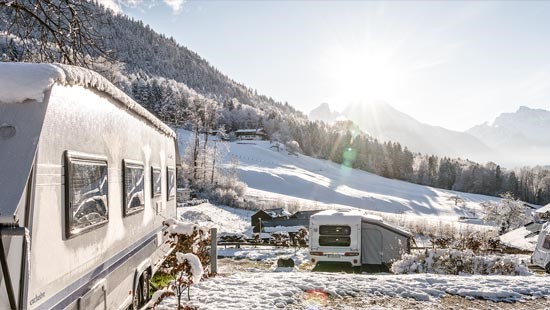Once your camper has all of the right equipment and you have made the essential preparations, you might ask yourself: “ What do I have to consider at the campsite when winter camping?”.

The fact is - a lot of things are different on a winter camping holiday than in summer. Due to the cold, for example, the cables could freeze or you might not be able to release your handbrake anymore. No one really wants that on their holiday, right? With the following tips, you'll be on the safe side on your winter camping trip:
The pitch site should be free of ice and snow to prevent the vehicle from sliding or tilting in times of thaw.
Boards under the wheels, the drawbar wheel and the supports prevent the caravan / motorhome from sinking in when the weather thaws.
Cover hand break lever, overrun device and gas bottles with canvas or plastic bags to prevent them from freezing.
Arrange power/electricity cables in an appropriate way that prevents them from freezing to the ground or being damaged while shovelling snow.
Use rubber cables. Plastic cables might break!
After setup: Release the hand break so that it does not freeze!
Hang separation curtains (alcove model) over single glazed windows in the driver’s cab of motorhomes or use insulating mats.
Never close forced ventilation and exhaust openings! The openings must not be snowed in or covered by snowbanks.
Never use catalytic heaters or infrared-gas heating systems! They extract oxygen from the air.
An awning serves as storage space, drying room, refrigerator and as a heat buffer. The steeper the roof, the easier it is to remove snow.
Hang covers on the refrigerator’s ventilation grilles.
Covers can be used to protect the bottom of the vehicle. Caution: Do not use on all four sides!
A pipe/chimney extension can be used to allow full circulation when it is snowing.
The chimney piece must be at least 10cm higher than baggage cases, ski-boxes, or racks on the roof. Only then can the heating work properly.
Leave the heater on, even during the night and when away for short periods of time. The temperature should not fall below 5°C.
Air regularly to ensure sufficient fresh air: open doors and windows for several minutes to allow the used, damp air to effuse and to let fresh, dry air in. Fresh air warms up faster.
In case of heavy snowfall: regularly remove snow from motorhome, caravan, and awning roof.
Drain water from uninsulated tanks during freezing temperatures. Put a bucket under the tap. Caution: pipes that run along the outside wall freeze easily too.
Condensed water easily accumulates on the interior walls (e.g. areas behind the backrest cushion of seats or under mattresses) when there is not enough fresh air. Check and dry these areas as needed.
Carpeting keeps your feet warm and helps to prevent damage caused by walking in ski shoes


